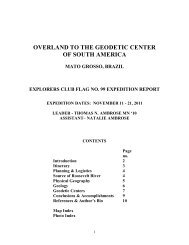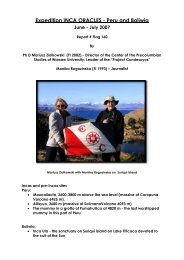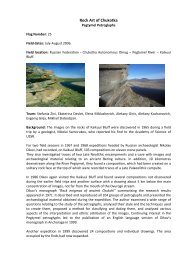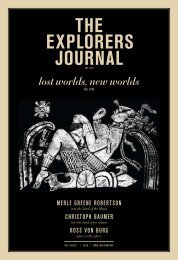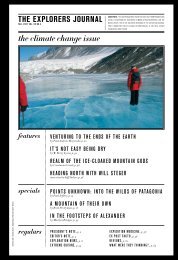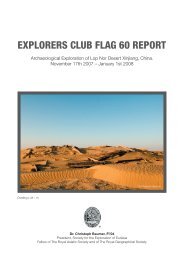the explorers journal - The Explorers Club
the explorers journal - The Explorers Club
the explorers journal - The Explorers Club
You also want an ePaper? Increase the reach of your titles
YUMPU automatically turns print PDFs into web optimized ePapers that Google loves.
would inevitably see not what is, but what once had<br />
been. He may as well have been describing <strong>the</strong> reality<br />
of <strong>the</strong> space-time continuum.<br />
If this sounds confusing it might help to consider<br />
<strong>the</strong> following dialectic. When we contemplate <strong>the</strong><br />
sprinkle of tiny orange and red glints spread liberally<br />
across <strong>the</strong> Hubble Ultra Deep Field image<br />
on page 46—an 11-day exposure constituting <strong>the</strong><br />
deepest look into space-time ever achieved in<br />
visible light—we’re looking at <strong>the</strong> earliest known<br />
galaxies. But while to us <strong>the</strong>y may seem incomparably<br />
ancient, in fact <strong>the</strong>y’re about as young as<br />
galaxies ever got. What we’re seeing is a real-time<br />
transmission from time’s edge. It’s a live feed, not<br />
a faded photograph. And <strong>the</strong>ir photons continue<br />
to shower in from all sides, impossibly faint: <strong>the</strong><br />
light of o<strong>the</strong>r days, uncut after its multibillion-year<br />
passage through <strong>the</strong> slow glass of <strong>the</strong> universe.<br />
Why are <strong>the</strong> youngest, most distant galaxies<br />
orange or red Because as <strong>the</strong>ir steady streams of<br />
photons pipe across space-time, <strong>the</strong>ir wavelengths<br />
shift due to <strong>the</strong> acceleration accompanying <strong>the</strong>ir<br />
great extension. Galaxies visible at time’s horizon,<br />
awash in <strong>the</strong> brilliant blue light of <strong>the</strong> giant, shortlived<br />
stars accompanying <strong>the</strong>ir birth, appear to<br />
change color with increasing distance—a phenomenon<br />
known as red shift. <strong>The</strong>ir light goes from blue<br />
to white, white to yellow, yellow to orange, orange<br />
to red, and finally from red to infrared. <strong>The</strong> most distant<br />
can only be discerned in infrared wavelengths—<br />
one reason why <strong>the</strong> upcoming James Webb Space<br />
Telescope, a successor to <strong>the</strong> Hubble, will operate<br />
exclusively in such frequencies. When even <strong>the</strong>se<br />
wavelengths go dark, it doesn’t necessarily mean<br />
that no galaxies are <strong>the</strong>re, only that <strong>the</strong>y’re so far<br />
away—and traveling so rapidly fur<strong>the</strong>r due to <strong>the</strong><br />
inexorable expansion of <strong>the</strong> universe—that it’s no<br />
longer possible to perceive <strong>the</strong>m. <strong>The</strong>ir piping has<br />
descended in register, finally merging with <strong>the</strong> surrounding<br />
rumble of space and time. <strong>The</strong>y’re lost in<br />
<strong>the</strong> craquelure of a very big picture.<br />
H o r s e h e a d N e b u l a<br />
<strong>The</strong> spectacular dark Horsehead Nebula, some 1,500 lightyears<br />
away, is actually a projection of <strong>the</strong> dense Orion<br />
Molecular Cloud. <strong>The</strong> gas and dust behind it is both illuminated<br />
and ionized, blazing from <strong>the</strong> five-star system known as Sigma<br />
Orionis, which causes <strong>the</strong> Horsehead to cast a shadow.Image<br />
taken by <strong>the</strong> Canada-France-Hawaii Telescope (CFHT).<br />
38




